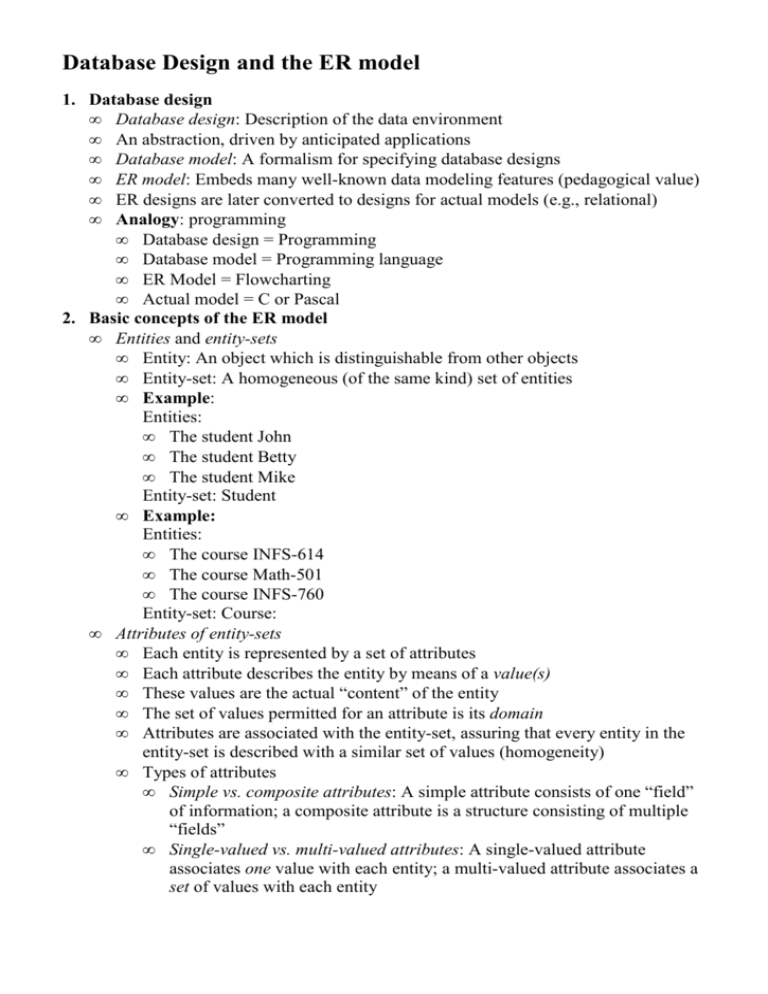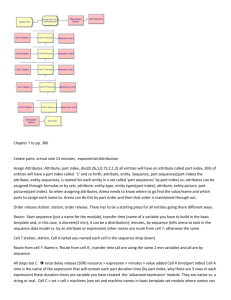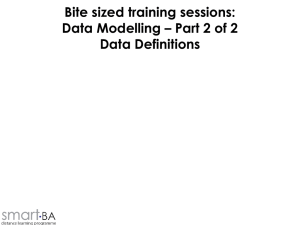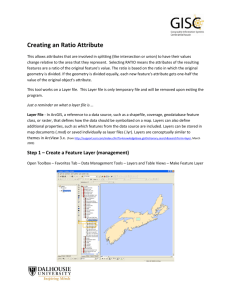er-model introduction
advertisement

Database Design and the ER model 1. Database design • Database design: Description of the data environment • An abstraction, driven by anticipated applications • Database model: A formalism for specifying database designs • ER model: Embeds many well-known data modeling features (pedagogical value) • ER designs are later converted to designs for actual models (e.g., relational) • Analogy: programming • Database design = Programming • Database model = Programming language • ER Model = Flowcharting • Actual model = C or Pascal 2. Basic concepts of the ER model • Entities and entity-sets • Entity: An object which is distinguishable from other objects • Entity-set: A homogeneous (of the same kind) set of entities • Example: Entities: • The student John • The student Betty • The student Mike Entity-set: Student • Example: Entities: • The course INFS-614 • The course Math-501 • The course INFS-760 Entity-set: Course: • Attributes of entity-sets • Each entity is represented by a set of attributes • Each attribute describes the entity by means of a value(s) • These values are the actual “content” of the entity • The set of values permitted for an attribute is its domain • Attributes are associated with the entity-set, assuring that every entity in the entity-set is described with a similar set of values (homogeneity) • Types of attributes • Simple vs. composite attributes: A simple attribute consists of one “field” of information; a composite attribute is a structure consisting of multiple “fields” • Single-valued vs. multi-valued attributes: A single-valued attribute associates one value with each entity; a multi-valued attribute associates a set of values with each entity • • • • • • Derived attribute: The value of this attribute can be computed from other related attributes or entities • Null value: Special value denoting not applicable (does not exist), missing (exists but not known), or unknown (unclear whether it exists or not) • Example: Student Student_Id, Year_of_Birth: simple, single-valued Telephone: simple, multi-valued Address: composite, single-valued Age: derived Relationships and relationship-sets • Relationship: Association among two or more entities • Relationship-set: A set of relationships, where the corresponding entities are from the same entity-set (homogeneity) • Example: Relationships: • The student John is enrolled in the course INFS-614 • The student Betty is enrolled in the course INFS-614 • The student Betty is enrolled in the course Math-501 • The student Mike is enrolled in the course INFS-760 Relationship-set: Enrollment Attributes of relationship-sets • Each relationship set may be associated with attributes • Example: Semester is attribute of the relationship-set Enrollment Note that semester is an attribute of neither Student nor Course Intension (entity-sets, relationship sets) vs. extension (entities, relationships) ER diagrams (Part 1) • Entity-set: rectangle • Relationship-set: diamond, connected with edges to participating entity-sets • Attribute: oval (double oval for multi-attribute, descendent ovals for attributes in composite attribute, dashed for derived attribute) Binary vs. n-ary relationship-sets: An n-ary relationship-set associates n entitysets; in a binary relationship-set n=2 • A non-binary relationship-set can always be simulated by several binary relationship-sets (and the addition of a new entity-set). • Example: Meeting 3 entity-sets Subject, Time, Location, and one 3-way relationship-set Meeting 4 entity-sets Meeting, Subject, Time, Location and 3 binary relationship-sets: MS, MT, ML 3. Integrity constraints • Impose restrictions on the extension • Contribute to the integrity (validity) of the extension, by rejecting any modifications (updates) that would result in violations of the restrictions • 1. Mapping cardinalities: Dictate how many entities may participate in each relationship of a binary relationship-set (mapping cardinality constraints on nonbinary relationships are not straightforward) • Types of mapping cardinalities: 1:1, 1:many, many:many • Example: StudentEnrolled-inCourse (many:many) • Example: FacultyAdvisesStudent (1:many) • Example: DepartmentChairFaculty (1:1) • Cardinality limits: lowest and highest cardinality allowed (* means no limit) • Example: StudentParticipates-inProject, where one student may work in 3-6 different projects and 1-5 students may work on same project. StudentParticipates-in is annotated 3..5, Participates-inProject is annotated 1..5. • 2. Total participation: Mandatory participation of entities in a relationship-set • Example: FacultyMemberDepartment • If each faculty must belong to a department, then FacultyMember is a total participation constraint. • If each department must have at least one faculty member then MemberDepartment is a total participation constraint • There is some overlap between cardinality limits and the combination mapping type/total participation: • highest=1: 1:many relationship (but arrow on other edge!) • lowest=1: total participation (double-line this edge!) • 3. Keys: Limit to one the number of entities that may share the same attribute(s) value • Allow identification of a unique entity within an entity set, by providing a value of the attribute(s) • Superkey: a subset of the attributes of an entity-set that uniquely identifies the entities • Candidate key: A minimal superkey • Primary key: A designated candidate key • Example: Student Attributes: Student_Id, Last_Name, First_Name, Age, Sex Superkeys: (Student_Id), (Student_id, Age), (Student_Id, Sex), etc. Candidate keys: (Student_id), (Telephone_No, Last_Name, First_Name) Primary Key: (Student_Id) • Simple vs. composite keys: A key with more than one attribute is composite, otherwise it is simple • Weak vs. strong entity-sets: An entity-set with a key is strong; otherwise it is weak • Example: INFS614_StudentSubmitHomework Student=(Student_Id, Student_Name, Major) Strong Homework=(Homework_No, Grade) Weak • A weak entity-set is permitted in ER designs, if 1. It is associated with a strong entity-set via a 1:many relationship-set 2. Participation of the weak entity-set in this relationship-set is total 3. The entities (of the weak entity-set) that are associated with the same entity (from the strong entity-set) are distinguishable by a subset of the attributes of the weak-entity-set (called discriminator) The discriminator attributes with the primary key of the strong entity-set constitute a key for the weak-entity-set • ER diagrams (Part 2) • Mapping cardinality: arrow-head on an edge representing “1” relationship • Cardinality limits: pair of values lowest..highest on the edge • Key attribute(s): underlined (dashed, for discriminator attribute(s) in a weak entity-set) • Weak entity-set: double rectangle (also double edge and double diamond to indicate the connection to the strong entity-set) • Total participation: double edge 4. Design possibilities • Entity-set participates in multiple relationship-sets • Example: FacultyAdvisesStudent, FacultyTeachesCourse • Multiple relationship-sets among the same entity-sets • Example: DepartmentChairFaculty, DepartmentMemberFaculty (note the possibility of the chair not being a member of the department) • Recursive relationship-sets • Example: EmployeeManagesEmployee • Solution 1: Multi-level hierarchy with entity-sets: President, Vice President, Manager, Employee and three 1:many relationship-sets Manages • Solution 2: Two identical entity-sets Employee1, Employee2 and one 1:many relationship-set Manages • Solution 3: One entity-set Employee and one recursive 1:many relationship-set Manages • Recursive relationships require annotating the role: one edge is marked “boss”, the other “subordinate” 5. Advanced features • Generalization/Specialization with inheritance • Entity-set B is a specialization of entity-set A (entity-set A is a generalization of entity-set B), if the entities in B are a subset of the entities in A • The relationship-set among the entity-sets A and B is 1:1 • Entity-set B does not store the attributes of A, as this would be redundant. Instead, these attributes are inherited from A • A generalization hierarchy of multiple levels is possible • Example: Grad_Student and Undergrad_Student are specializations of Student Student and Faculty are specializations of University_Person • Example: Programmer and Engineer are specializations of Employee Part_Time and Full_Time are also specializations of Employee • Disjoint vs. overlapping: is it possible for an entity to belong to more than one “subclass”? • Example: Grad-Student and Undergrad_Student are disjoint Programmer, Engineer, Part_Time, Full_Time are overlapping • Total vs. partial: Can there be “superclass” entities that do not belong to any “subclass”? • Example: Honor_Student is a specialization of Student. Students who are not honor students belong only to the superclass. • Example: Honor_Student and Non_Honor_Student are specializations of Student. All students belong to a subclass • Generalizations are justified if there are applications that would use both the general and specialized entity-sets • Generalizations can also be modeled with weak entity sets and 1:1 relationship-sets • Aggregation • Encapsulate a relationship-set and its associated entity-sets in one (higher level) entity-set • Example: The 3-way relationship-set Meeting (and its entity sets Subject, Time, Location) can be aggregated in a single entity-set Meeting1, which may then participate in a many:many relationship with the entity-set Employee • Advantage: Solves modeling problems that are otherwise difficult to represent unambiguously • ER diagrams (Part 3) • Generalization/specialization: triangle standing on its tip • Total generalization: double edge to the higher entity-set • Disjoint generalization: the word “disjoint” next to triangle • Aggregation: box the aggregated portion in a rectangle (similar to entity-set) 6. Design issues • Avoid redundancies, as they might introduce inconsistencies • Example: StudentSubmitTermPaper, where Term_Paper=(Student_No, Course, Grade) Student_No is represented twice, and it becomes possible for one student to “own” term papers by other students • Example: Prefer StudentMajorDepartment over Major as attribute of Student • ER design alternatives: Attribute or entity-set? • If there are things to be said about the attribute, then it should become an entity-set • Example: If we want to record the capacity of a room, then it should become an entity-set • • If we need to ask about values not used, then it should become an entity set • Example: Find a room available on Monday between 4 and 5. Justifies an entity-set Room ER design methodologies • Strategy for large design tasks: 1. Design several independent views, each describing one natural subpart (or pertaining to a subset of the applications) 2. Merge the independent views into a single design







